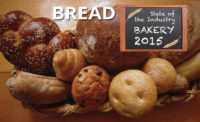Pizza, in its purest form—resplendent in gooey cheese, an unabashed refined-flour crust and perhaps a bold scattering of spicy Italian sausage—is synonymous with outright indulgence. And in a food industry where health and wellness impacts everything, that spells trouble to the bottom line. Add in an improving economy, enabling more people to satisfy their desires for comforting indulgences via the local pizzeria, and flat category performance predictably arises as par for the course.
Overview | Bread | Tortillas | Sweet Goods | Snack Cakes | Pizza | Desserts | Cookies | Buns & Rolls | Bars
But despite the lack of any strong category-wide growth over the past year, select segments within pizza represent glimpses of innovation. Manufacturers continue to strive toward replicating pizzeria-style traits in frozen retail pizzas, while gluten-free has introduced new streams of revenue. Suppliers continue to offer new ingredients for benchtop R&D experimentation, while equipment manufacturers regularly build new, dynamic capabilities into pizza manufacturing that improve quality while streamlining production.
And don’t forget that we’re talking about a large, mature segment of food that encompasses multiple categories that collectively account for an estimated $5.5 billion in annual business, per Mintel. That’s a sizeable pie to slice into as manufacturers jockey for increased market share.
Market data
While the retail pizza market was relatively flat over the past year, it’s still a significant segment, with frozen pizza accounting for $4.4 billion despite only nominal 0.68 percent growth in dollar sales for the 52 weeks ending April 19, 2015, per IRI, Chicago. Frozen pizza dough and crusts accounted for $20.6 million, down 1.39 percent in dollar sales. Over in the refrigerated case, pizza crusts and dough brought in a stronger $85.5 million, but again saw a slight decline of 0.10 percent in dollar sales.
Meanwhile, over in the deli case, refrigerated pizzas and pizza kits grew 1.91 percent in dollar sales to $354.2 million, with private label taking in the lion’s share of sales at $287.3 million.
Nestlé continues to dominate the frozen pizza segment, with $1.9 billion in sales over the past year. The Schwan Food Co. comes in second, with $900.0 million, followed by private label at No. 3.
Elsewhere in pizza, private label leads in the frozen pizza crusts and dough segment, with $5.5 million in sales. Private label takes the No. 2 slot in refrigerated pizza crusts and dough, and strongly leads the pack in refrigerated pizza at $287.3 million; No. 2 in that segment, Huntsman Gay Global Capital—owner of the MaMa Rosa’s brand—saw $28.8 million in sales.
Looking back
Frozen pizza kits and toppings, a new category this past year, saw $12.2 million in sales, per IRI, with one product accounting for that total—the new DiGiorno Design a Pizza Kit from Nestlé, which provides frozen chicken, green peppers, red onions and pepperoni for users to create their own, customized pizza at home. Considering this strong first-year performance, expect to see other manufacturers, possibly including private label, enter this category.
Gluten-free has found a home in frozen pizza crusts. Boulder Brands, second only to private label in the segment, has seen strong performance of its Udi’s Gluten Free Foods brand, taking in $5.2 million for the period, up 7.12 percent in dollar sales. The brand has now received additional exposure (and diversified revenue) via its role as the exclusive supplier of gluten-free crusts for Pizza Hut, with branding on the box to boot. Kinnikinnick Foods, another manufacturer of gluten-free crusts, follows in the No. 3 slot.
In traditional frozen pizza dough, Stefano Foods is out front. The brand brought in $1.3 million over the 52-week period, up a healthy 13.44 percent in dollar sales. In 2013, the brand lineup saw the addition of a new premium dough product made with European “00” flour, olive oil and garlic, merchandised in the refrigerated section.
In refrigerated pizza dough, the Pillsbury brand from General Mills leads by a wide margin. The line now includes Artisan (made with whole grains), Classic, Thin and Gluten Free Thin dough products.
Artisan-inspired pizzas are showing strength in the frozen pizza market. DiGiorno, the leading frozen pizza brand with $958 million in sales over the 52-week period, now offers a Pizzeria! line that displays an irregularly shaped—albeit standardized—crust, with varieties comprising Primo Pepperoni, Pizzeria Bianca (crème fraiche and garlic sauce and spinach), Supreme Speciale (yellow onion, green bell pepper, red bell pepper, Italian sausage and pepperoni), Quattro Formaggi/Four Cheese (fontina, mozzarella, Parmesan and Pecorino Romano), Italian Style Meat Trio (Genoa salami, pepperoni and Italian sausage) and Tuscan Chicken (grilled chicken, tomatoes and spinach). The combination of selectively specialized ingredients and crust style helped the line bring in $93.9 million in sales over the period.
The Schwan Food Co. likewise has built an artisan feel into is Red Baron Brick Oven line, with a crust it describes as “crispy” and “bubbly” that’s formulated with varying degrees of undulation on its outer edge.
These crust developments reflect a desire to narrow the gap between frozen pizza and pizzeria pizza—but foodservice continues to raise the bar. “Over the past year, we’ve seen continued interest in authentic Neapolitan-style pizzas, driven by artisan wood-fired and coal-fired pizzerias,” says Don Trouba, director, marketing, Ardent Mills, Denver.
Replicating pizzeria traits in a frozen retail product can pose challenges. Eric Riggle, vice president, Rademaker USA, Hudson, OH, notes that he’s been seeing a trend toward more artisan-style pizza crusts “characterized by a more-open cell structure. We also see very thin, cracker-style crusts being demanded more and more. These doughs benefit from a long prefermentation period, for both the open cell structure, but also an improvement in taste and flavor.” He notes that they are often dubbed “artisan-style” or “bistro-style” pizza crusts.
In order to process these prefermented styles of pizza doughs, Riggle recommends low-stress sheeting. Such systems “create a nearly tensionless dough sheet, which does not damage or stress these delicate, prefermented pizza doughs,” he says. They can be coupled with inline prefermentation conveying systems, he notes, “which are specially designed to control temperature, humidity and airflow to not dry out the dough and create a uniquely flavored dough in the most-consistent ?method.”
Hard, cracker-style pizza doughs can typically stand up to a heavier-duty, executed processing line, notes Riggle. “Larger, 16-inch-diameter, solid rollers and unique gap adjustments provide the thinnest doughs in the most-consistent manner.”
Single-serving pizzas also continue to perform well. The Schwan Food Co.’s Red Baron Singles line—available in Deep Dish and French Bread—had $150.2 million in sales for the 52 weeks ending April 19, 2015, per IRI. Microwavable Celeste Pizza for One, a Pinnacle Foods brand, also continues to draw sales, hitting $62.7 million for the period. The line now features 10 products.
Looking forward
Pizzeria culture undeniably impacts retail trends. “The more the North American consumer eats out and enjoys these bistro-style pizzas, the more they demand these pizza types to enjoy at home,” says Riggle.
“Pizza innovation often happens at the restaurant level, and when we look at that portion of the market, we see a lot happening with regard to toppings and crusts,” says Trouba. “Artisan pizzerias have given people more flavors to experience, and they’re now starting to look at crusts.” Higher-end crusts often rely on Italian-style flour—typically “00” flour due to its high protein content—to achieve pizzeria-style crust taste and texture.
For school foodservice—where at least 50 percent of grains must be whole grain—Trouba recommends white whole-wheat flour to avoid changes to expected taste, texture or appearance. “Pizza is one of the most-important categories, and with menus coming under increased scrutiny, the shift to whole grains will be an important one,” he says.
“One trend that we have begun to see on the QSR restaurant side is an increased focus on authenticity,” says Zachery Sanders, director, marketing, Ardent Mills. “Restaurants are creating new pizza offerings with a stronger tie to global cooking styles and ingredients. Brick-oven and wood-fired cooking is more prevalent, and we’ve seen quite a few new introductions utilizing more new and artisan-style ingredients, such as kale, feta or gorgonzola cheeses, Peruvian cherry peppers and ancient grains. Grains such as quinoa can provide an interesting spin and alternative to traditional meat toppings. Teff, millet, sorghum and other ancient grains can provide additional flair to pizza crusts through unique flavors and visual appeal. Ancient grains are extremely nutritious and most are naturally gluten-free, making them useful in ‘better- for-you’ pizza ?applications, as well.”
Trouba calls the crust “the next frontier for pizzas,” potentially opening the door to newfound experimentation with different grains. He also suggests that adventurous consumers are seeking “like-minded” products and pizzerias—products that resonate with their dietary patterns and lifestyle. In addition to ancient grains, another on-trend grain along these lines, he notes, is sprouted whole-wheat flour.
Such ingredients, says Trouba, bring “culinary adventure” to the pizza category. Pizza crusts made with buckwheat, or amaranth and quinoa, can pair nicely with Asian and Latin flavors, respectively. “They’re not traditional pizzas, but they get people thinking, and it can make sense from a culinary perspective,” he says.
Formulators can also flex pizza-product formats. “Pizza snacks are becoming more and more popular, with items such as mini pizzas, pretzel pizza sticks or hamburger pizzas,” says Paul Rooijmans, sales manager, Tromp Group Americas, Atlanta. “There is new variety requested in pizza shapes and flavors outside the traditional pizza product.” He also suggests pretzel-style pizza crusts as a forward-thinking concept.
The idea of a pretzel-style crust hit foodservice in 2014, with Little Caesars and then Pizza Hut experimenting with the concept. Over in retail, J&J Snack Foods Corp. carries the bite-sized Pizza Superpretzel snack in its Pretzelfils line, as well as a full-sized Pizza Pretzel in its Kim & Scott’s Gourmet ?Pretzel line.
Incorporating forward-trending ingredients and styles into pizza crusts and flatbreads, borrowed from other bakery categories, can open up new flavor and ingredient sensations that beg for benchtop experimentation. Sweet potato—which is starting to surface in tortillas—might resonate in better-for-you pizza. Nutritious, anthocyanin-rich purple corn is also a colorful ingredient option that chefs have begun to incorporate into crusts.
And retail has only begun to scratch the surface of prevailing pizza styles in play across the industry: Roman, Sicilian, Neapolitan, Chicago, New Haven, New York … the list goes on and on.
When we consider the wide range of baking techniques, grains and other ingredients we apply only to pizza crusts—and then add in the nearly limitless permutations of sauces, toppings and product formats—the pizza segment transforms into a veritable blank slate. Alignment with pizzeria trends and quality is only one approach toward capturing more of the pizza pie. Health halos like clean label, gluten-free and artisan—along with truly better-for-you approaches like using more and diverse whole grains and other nutrition-forward crust ingredients—also present opportunities. Collectively, these variables open up a largely unexplored world of pizza-fed inspiration.
Overview | Bread | Tortillas | Sweet Goods | Snack Cakes | Pizza | Desserts | Cookies | Buns & Rolls | Bars















